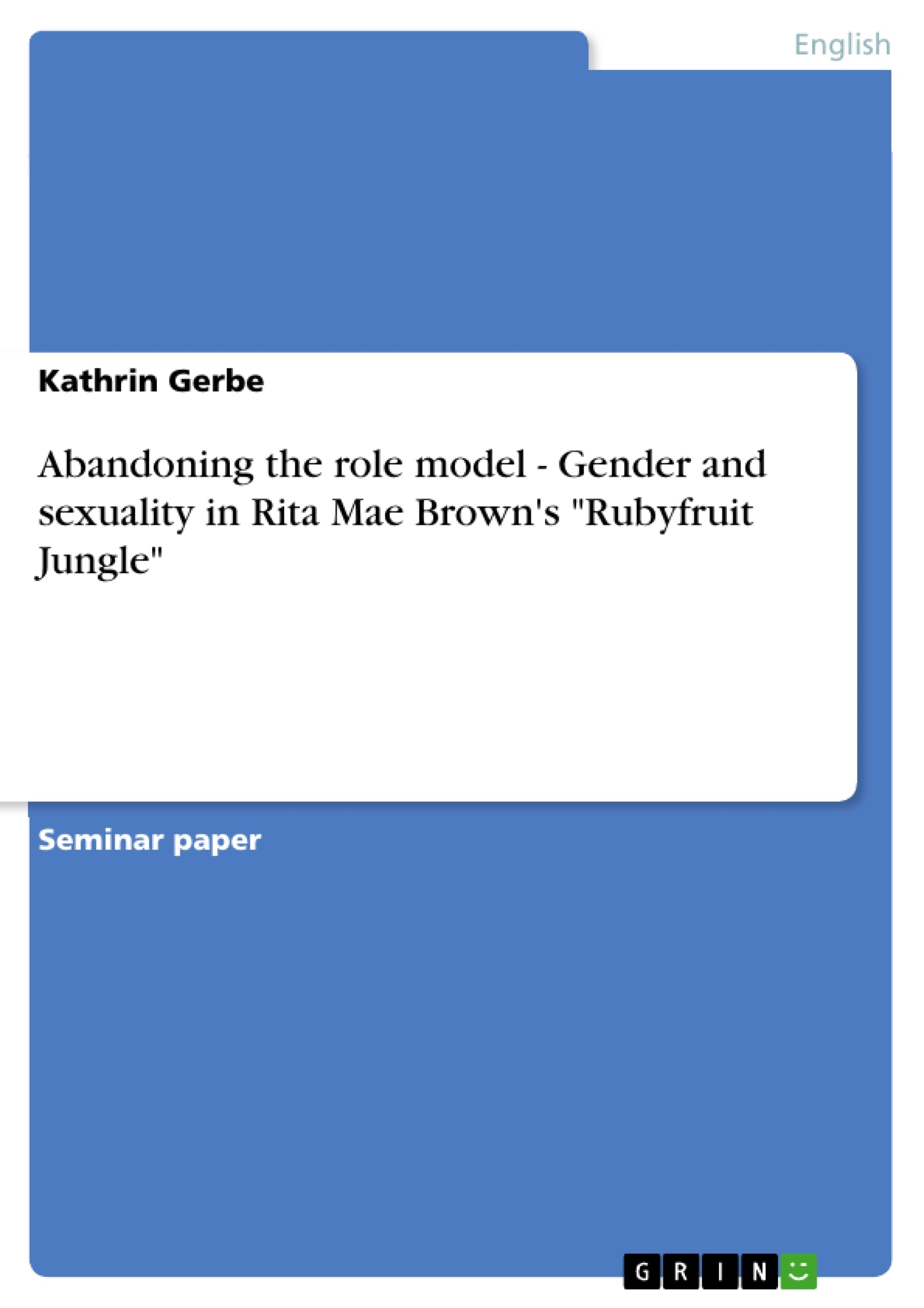From its beginnings, American society was a system based on certain values, e.g. Christianity. These values are affected by events like war, waves of immigration and the fluctuations of economy and therefore change constantly. In those changing times, family was meant to be a fixed value in society but in the 20th century they started to disintegrate, especially referring to the role model of women.
This paper discusses the presentation of gender and sexuality in Rita Mae Brown's novel "Rubyfruit Jungle", including female role models and homosexuality in the context of the ever present conventions in 1960s America.
Table of Contents
- Introduction - a survey of family and female life in the American society of the 1960s
- Gender and sexuality in R. M. Brown's Rubyfruit Jungle
- Role-model housewife and mother
- Carrie
- Other examples
- Molly - a self-made woman?
- Molly and the role model
- Molly a self-made woman?
- Role-model housewife and mother
- Conclusion
Objectives and Key Themes
This paper aims to examine the portrayal of gender and sexuality in Rita Mae Brown's Rubyfruit Jungle, specifically focusing on how the novel presents the feminine role model prevalent in 1950s and 1960s American society. It analyzes how the characters in the novel either conform to or challenge these societal expectations.
- The feminine role model in 1960s America
- The portrayal of different types of women in Rubyfruit Jungle
- The concept of the "self-made woman" in contrast to societal expectations
- The exploration of homosexuality within the context of societal norms
- The complexities of motherhood and family relationships
Chapter Summaries
Introduction – a survey of family and female life in the American society of the 1960s: This introductory chapter sets the stage by providing a concise overview of the traditional family structure and the prescribed role of women in 1960s American society. It utilizes statistical data from the era to illustrate the limited opportunities available to women in education, employment, and overall societal participation. The chapter emphasizes the dominant image of the woman as a homemaker and mother, contrasting this with the emerging challenges to this traditional model. It establishes a framework for understanding the societal pressures and expectations that shape the characters' lives in the subsequent analysis of Rubyfruit Jungle.
Gender and sexuality in Rita Mae Brown's Rubyfruit Jungle: This chapter introduces Rita Mae Brown's Rubyfruit Jungle and its central themes of homosexuality and the complexities of the feminine role model within the social context of the 1950s and 60s. It serves as a bridge, connecting the societal backdrop established in the introduction to the literary analysis that follows. The chapter highlights the diverse portrayals of women within the novel, foreshadowing the examination of characters who either embody or defy traditional gender roles.
Keywords
Feminine role model, gender roles, sexuality, homosexuality, 1960s America, societal expectations, Rubyfruit Jungle, Rita Mae Brown, motherhood, self-made woman, lesbian identity, family relationships.
Rubyfruit Jungle: A Literary Analysis - Frequently Asked Questions
What is the main focus of this literary analysis?
This paper examines the portrayal of gender and sexuality in Rita Mae Brown's Rubyfruit Jungle, specifically focusing on how the novel presents the feminine role model prevalent in 1950s and 1960s American society. It analyzes how the characters in the novel either conform to or challenge these societal expectations.
What are the key themes explored in the analysis?
Key themes include the feminine role model in 1960s America; the portrayal of diverse women in Rubyfruit Jungle; the concept of the "self-made woman" in contrast to societal expectations; the exploration of homosexuality within societal norms; and the complexities of motherhood and family relationships.
What is included in the Table of Contents?
The Table of Contents includes an introduction surveying family and female life in 1960s America; a section on gender and sexuality in Rubyfruit Jungle, further broken down into subsections analyzing specific characters and their roles; and a conclusion.
How does the analysis approach the topic of gender roles?
The analysis contrasts the traditional feminine role model of the 1960s with the representations of women in Rubyfruit Jungle. It explores how characters either conform to or challenge these expectations, examining the complexities and contradictions inherent in these societal norms.
What is the significance of the "self-made woman" concept in the analysis?
The analysis examines the concept of the "self-made woman" as a counterpoint to the prescribed feminine role model of the 1960s. It explores how characters in the novel either achieve or strive for self-sufficiency, independence, and autonomy, potentially challenging traditional expectations.
How does the analysis incorporate historical context?
The analysis uses statistical data from the 1960s to illustrate the limited opportunities available to women and the dominant image of the woman as a homemaker and mother. This historical context helps to illuminate the societal pressures and expectations that shape the characters' lives in Rubyfruit Jungle.
What role does homosexuality play in the analysis?
The analysis examines the portrayal of homosexuality in Rubyfruit Jungle within the context of 1960s societal norms. It explores how lesbian identity is represented and the challenges faced by homosexual characters in navigating societal expectations.
What are the chapter summaries?
The introduction provides an overview of traditional family structures and women's roles in 1960s America. The main chapter delves into Rubyfruit Jungle, analyzing its themes of homosexuality and the complexities of the feminine role model. These summaries highlight the diverse portrayals of women and the characters' interactions with societal norms.
What are the keywords associated with this analysis?
Keywords include: Feminine role model, gender roles, sexuality, homosexuality, 1960s America, societal expectations, Rubyfruit Jungle, Rita Mae Brown, motherhood, self-made woman, lesbian identity, family relationships.
- Quote paper
- BA, MA Kathrin Gerbe (Author), 2005, Abandoning the role model - Gender and sexuality in Rita Mae Brown's "Rubyfruit Jungle", Munich, GRIN Verlag, https://www.grin.com/document/45943




